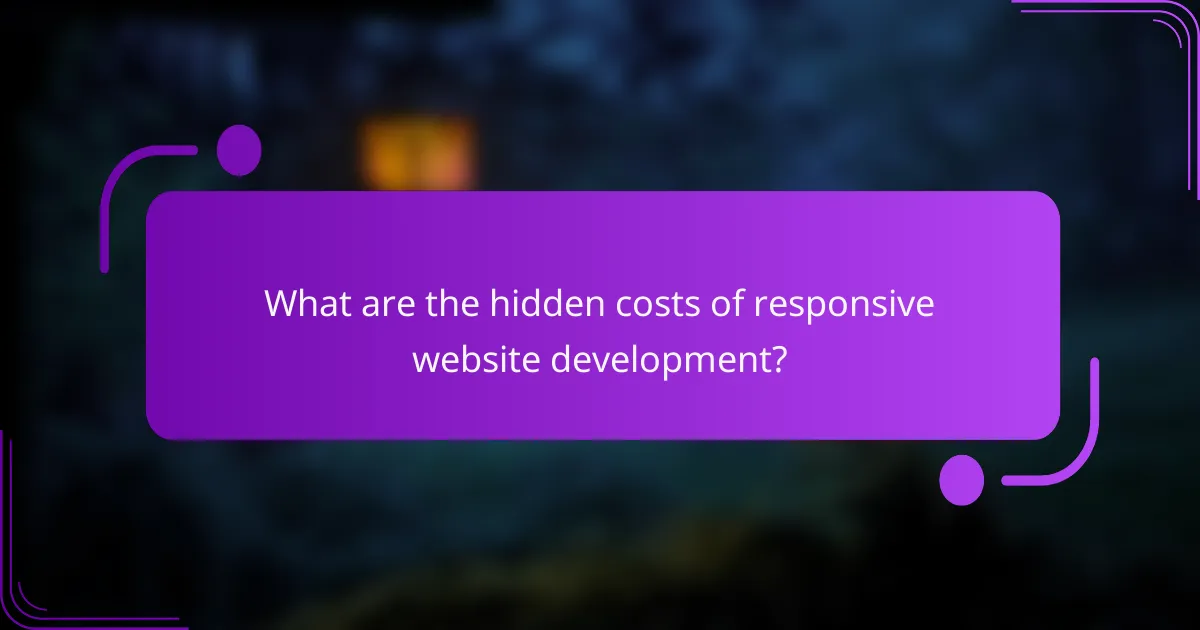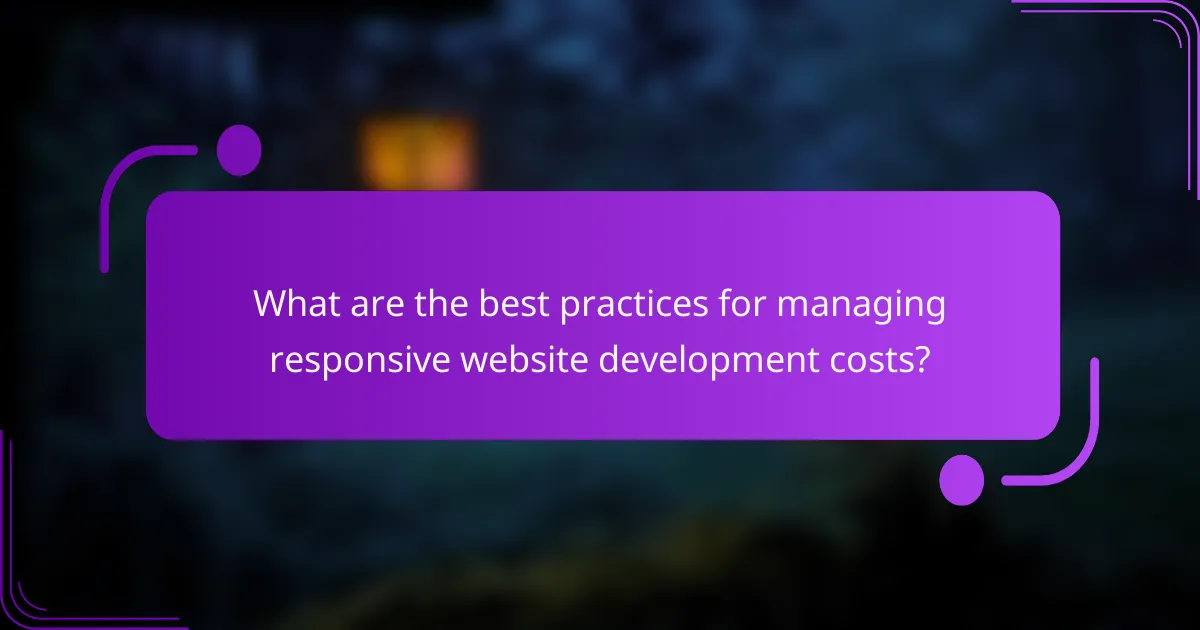Responsive website development can often come with hidden costs that clients may not anticipate during the initial budgeting phase. These expenses, which include ongoing maintenance, hosting charges, and SEO investments, can significantly impact the overall project budget. By conducting thorough assessments and understanding the complexities involved, clients can better prepare for these costs and ensure a smoother development process.

What are the hidden costs of responsive website development?
Hidden costs in responsive website development often arise from ongoing expenses that clients may overlook during initial budgeting. These can include design and development expenses, ongoing maintenance fees, content management system costs, hosting charges, and SEO investments.
Design and development expenses
While the initial design and development costs may seem straightforward, additional expenses can emerge from revisions, user testing, and the need for specialized skills. For instance, hiring a UX designer or a front-end developer can significantly increase the budget, often adding thousands of dollars to the final cost.
Moreover, if the project scope changes after development begins, it can lead to further costs. Clients should clearly define project requirements upfront to minimize unexpected expenses later.
Ongoing maintenance fees
Responsive websites require regular maintenance to ensure they function correctly across various devices and browsers. This includes software updates, security patches, and troubleshooting issues that may arise over time. Clients should anticipate spending around 15-20% of the initial development cost annually on maintenance.
Neglecting maintenance can lead to larger issues down the line, making it crucial to budget for these ongoing expenses from the start.
Content management system costs
Many responsive websites utilize content management systems (CMS) that come with their own costs. These can include licensing fees, plugin purchases, and costs for premium themes or templates. Depending on the CMS, clients might pay monthly or annual fees that can add up significantly.
Choosing an open-source CMS can reduce initial costs, but clients should still consider the potential expenses for customization and support services.
Hosting and infrastructure charges
Reliable hosting is essential for responsive websites, and costs can vary widely based on the hosting provider and the level of service required. Shared hosting can be economical, but dedicated servers or cloud hosting options may be necessary for higher traffic sites, leading to increased monthly fees.
Clients should evaluate their expected traffic and choose a hosting plan that can scale with their needs, as underestimating this can result in performance issues and additional costs.
SEO and marketing investments
Investing in SEO and digital marketing is crucial for driving traffic to a responsive website. This can include costs for keyword research, content creation, and link-building strategies. Clients should budget for ongoing SEO efforts, which can range from hundreds to thousands of dollars monthly depending on the competitiveness of their industry.
Failing to allocate funds for marketing can hinder the website’s visibility and overall success, making it a critical aspect of the development budget.

How can clients prepare for these costs?
Clients can prepare for hidden costs in responsive website development by conducting thorough assessments, researching providers, requesting detailed quotes, and understanding project scope and timelines. This proactive approach helps in minimizing unexpected expenses and ensures a smoother development process.
Conduct thorough budget assessments
Start by evaluating your overall budget for the project, including not just the initial development costs but also ongoing expenses such as maintenance and updates. Consider allocating an additional 10-20% of your budget to cover unforeseen costs that may arise during development.
Break down your budget into specific categories, such as design, development, and testing. This will help you identify areas where you might need to adjust your expectations or seek additional funding.
Research potential service providers
Take the time to research various web development companies to find those that specialize in responsive design. Look for providers with a solid portfolio and positive client reviews to gauge their reliability and expertise.
Consider reaching out to other businesses in your industry for recommendations. Networking can provide insights into which service providers have delivered quality work and value for money.
Request detailed quotes
When you approach potential service providers, request detailed quotes that outline all aspects of the project. A comprehensive quote should include costs for design, development, testing, and any additional services like SEO or content creation.
Compare quotes from multiple providers to identify discrepancies and ensure you are getting a fair price. Look for transparency in pricing, as hidden fees can significantly impact your budget.
Understand project scope and timelines
Clearly define the project scope to avoid scope creep, which can lead to increased costs and extended timelines. Outline specific features, functionalities, and design elements you want included in the final product.
Establish realistic timelines for each phase of the project. Discuss deadlines with your service provider to ensure they can meet your expectations without compromising quality. Regular check-ins during the development process can help keep the project on track and within budget.

What factors influence the cost of responsive website development in major US cities?
The cost of responsive website development in major US cities is influenced by various factors, including regional labor rates, market demand for web services, and the complexity of design requirements. Understanding these elements can help clients better budget for their projects and avoid unexpected expenses.
Regional labor rates
Labor rates for web developers can vary significantly across different US cities. For instance, metropolitan areas like San Francisco and New York typically have higher hourly rates, often ranging from $100 to $250, while cities in the Midwest may see rates between $50 and $100. Clients should consider these regional differences when planning their budgets.
Additionally, the experience level of the developers can impact costs. Junior developers may charge lower rates, but they might require more oversight and time, potentially leading to higher overall expenses. Balancing expertise with budget constraints is crucial.
Market demand for web services
The demand for web services can greatly affect pricing in various regions. In cities with a booming tech scene, such as Austin or Seattle, demand often drives prices up due to competition for skilled developers. Conversely, in areas with less demand, clients may find more competitive pricing.
Clients should stay informed about local market trends and consider timing their projects to coincide with lower demand periods, which can lead to more favorable rates. Engaging with multiple service providers can also help gauge the market landscape.
Complexity of design requirements
The complexity of a website’s design directly influences development costs. Simple, template-based sites are generally less expensive to create, while custom designs with advanced features can significantly increase the budget. For example, a basic responsive site might cost a few thousand dollars, while a highly interactive platform could reach tens of thousands.
When planning a project, clients should clearly outline their design requirements and prioritize essential features. This can help manage costs and ensure that the final product aligns with their vision without unnecessary expenditures. Regular communication with developers throughout the design process can also prevent costly revisions later on.

What are the best practices for managing responsive website development costs?
To effectively manage costs in responsive website development, it is essential to establish clear project goals, utilize agile methodologies, and implement cost-tracking tools. These practices help ensure that resources are allocated efficiently and that unexpected expenses are minimized.
Establish clear project goals
Defining clear project goals is crucial for keeping development costs in check. This involves outlining the specific features, functionalities, and target audience for the website. By having a well-defined scope, teams can avoid scope creep, which often leads to increased costs.
Engage stakeholders early to gather input and align expectations. Creating a project brief that includes objectives, timelines, and budget estimates can serve as a reference point throughout the development process.
Utilize agile development methodologies
Adopting agile development methodologies allows teams to remain flexible and responsive to changes. This iterative approach enables developers to deliver work in small increments, allowing for regular feedback and adjustments. As a result, potential issues can be identified and addressed early, reducing the likelihood of costly revisions later.
Consider organizing work into sprints, typically lasting one to four weeks, where specific tasks are completed and reviewed. This structure helps maintain focus on immediate goals while keeping the overall project on track.
Implement cost-tracking tools
Using cost-tracking tools can provide valuable insights into spending patterns during the development process. These tools help monitor expenses in real-time, allowing project managers to identify areas where costs may be exceeding expectations. Regularly reviewing this data can facilitate informed decision-making.
Popular cost-tracking tools include software like Trello, Asana, or dedicated budgeting applications. Establish a routine for updating and reviewing financial data to ensure that the project remains within budget and any necessary adjustments can be made promptly.
